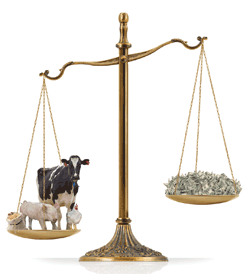The author is president and CEO of Stewart-Peterson.
Recently, I read two books that sum up the importance of being prepared for the unexpected. First, The Big Short, by Michael Lewis, describes the lead-up to the housing crisis and subsequent economic collapse. Second, The Wave, by Susan Casey, describes the improbable, but nevertheless factual, existence of 80-foot ocean waves that topple oil rigs and toss ocean liners.
Both books talked about "outlier events" that are statistically impossible to predict. Yet, they described how all the elements could fall in place for some massive event - like a wave or an economic collapse - to happen.
 My point in sharing this story is to encourage you to manage your business with outlier events in mind. In today's world, it may be statistically difficult to predict what will happen in our economy, the weather or the markets, and at the same time, we've seen over and over again that when people think something can't happen, it does.
My point in sharing this story is to encourage you to manage your business with outlier events in mind. In today's world, it may be statistically difficult to predict what will happen in our economy, the weather or the markets, and at the same time, we've seen over and over again that when people think something can't happen, it does.
That's why I wrote the "$12 Corn Special Report" back in 2006. We were moving into a global economy with worldwide interest in buying commodities, rapidly growing ethanol demand, and a financial structure that indicated elevators would soon run out of margin money should prices turn bullish. It looked as if all we needed was the perfect storm of all these factors converging, and commodity prices would go to record highs. It happened, and they did.
That's what led me to author another special report entitled, "Heads Up: A Futuristic View of U.S. Agriculture and the World, and What You Can Do To Protect Your Prosperity." The report encourages farmers to think about what could happen and to prepare for all possibilities. After all, agriculture has some very bright days ahead - for those who are prepared. Here are some highlights:
Domestic demand and a growing global middle class are big drivers behind commodity prices right now. In the U.S., even though high prices killed the ethanol plants for awhile, they have come back strong and are burning through nearly 5 billion bushels of corn a year. The buy-and-hold commodity investors are back in the game again, and China and others keep importing crops to feed their people.
These days, the supply-demand balance is leaning toward almost no carryover in major commodities. Should we have a widespread drought, the bullish demand this would add is almost beyond comprehension.
With all this bullishness, it is easy to think that prices can never come down. Remember, it only takes the swipe of a pen in Washington, an earthquake, political unrest in a major buying country, or one big bumper crop that eases supply concerns and prices fall.
As we move forward, bullish prices for agricultural commodities could continue at a rate that leads to very attractive levels of profitability for agricultural producers. In the meantime, other sectors of the economy will struggle and are likely to continue struggling for years to come. How long, then, is it going to take for outside investors to look to agriculture and decide that their money is best invested in farming?
It's already happening in farmland; it could happen with well-managed farm operations. Yes, for all the years that agriculture has been taken for granted and overlooked, we are finally getting some company . . . maybe unwanted company.
The good news is that some farmers will have the opportunity to sell their farms at prices they never dreamed of and enjoy the fruits of a lifetime of labor. The sad side is that those who try and fail to manage volatility by locking in profit margins will be driven from the industry and forced to sell out. This consolidation of farms could bring about massive structural changes in agriculture that will have significant impact on rural communities.
What happens when outside investors buy up farms? A dramatic shift, in that many producers will no longer be farming ground they own. Instead, they will be custom-farming ground for outside investors. Under this scenario, farmers wouldn't control the land and wouldn't control the commodity they are producing. The farmer would work and not benefit from the profitable prices. This is an extreme thought; however, when you think about just how good most producers are at producing commodities, it is not beyond comprehension.
How do you respond?
Maximize your profits or others will. In today's world, all buyers and sellers of commodities must be prepared for any scenario.
The downfall of rural America is only going to occur if independent producers across this country do not take advantage of record prices when they occur and protect themselves from outlier events. Those who leave money on the table are leaving opportunity to be snatched up by others, and their businesses will suffer.
For expanded coverage on what the future could hold for agriculture, Scott Stewart's latest report, "Heads Up: A Futuristic View of U.S. Agriculture and the World, and What You Can Do To Protect Your Prosperity" can be obtained by e-mailing scotts@stewart-peterson.com or calling 800-334-9779.
Recently, I read two books that sum up the importance of being prepared for the unexpected. First, The Big Short, by Michael Lewis, describes the lead-up to the housing crisis and subsequent economic collapse. Second, The Wave, by Susan Casey, describes the improbable, but nevertheless factual, existence of 80-foot ocean waves that topple oil rigs and toss ocean liners.
Both books talked about "outlier events" that are statistically impossible to predict. Yet, they described how all the elements could fall in place for some massive event - like a wave or an economic collapse - to happen.
 My point in sharing this story is to encourage you to manage your business with outlier events in mind. In today's world, it may be statistically difficult to predict what will happen in our economy, the weather or the markets, and at the same time, we've seen over and over again that when people think something can't happen, it does.
My point in sharing this story is to encourage you to manage your business with outlier events in mind. In today's world, it may be statistically difficult to predict what will happen in our economy, the weather or the markets, and at the same time, we've seen over and over again that when people think something can't happen, it does.That's why I wrote the "$12 Corn Special Report" back in 2006. We were moving into a global economy with worldwide interest in buying commodities, rapidly growing ethanol demand, and a financial structure that indicated elevators would soon run out of margin money should prices turn bullish. It looked as if all we needed was the perfect storm of all these factors converging, and commodity prices would go to record highs. It happened, and they did.
That's what led me to author another special report entitled, "Heads Up: A Futuristic View of U.S. Agriculture and the World, and What You Can Do To Protect Your Prosperity." The report encourages farmers to think about what could happen and to prepare for all possibilities. After all, agriculture has some very bright days ahead - for those who are prepared. Here are some highlights:
Domestic demand and a growing global middle class are big drivers behind commodity prices right now. In the U.S., even though high prices killed the ethanol plants for awhile, they have come back strong and are burning through nearly 5 billion bushels of corn a year. The buy-and-hold commodity investors are back in the game again, and China and others keep importing crops to feed their people.
These days, the supply-demand balance is leaning toward almost no carryover in major commodities. Should we have a widespread drought, the bullish demand this would add is almost beyond comprehension.
With all this bullishness, it is easy to think that prices can never come down. Remember, it only takes the swipe of a pen in Washington, an earthquake, political unrest in a major buying country, or one big bumper crop that eases supply concerns and prices fall.
As we move forward, bullish prices for agricultural commodities could continue at a rate that leads to very attractive levels of profitability for agricultural producers. In the meantime, other sectors of the economy will struggle and are likely to continue struggling for years to come. How long, then, is it going to take for outside investors to look to agriculture and decide that their money is best invested in farming?
It's already happening in farmland; it could happen with well-managed farm operations. Yes, for all the years that agriculture has been taken for granted and overlooked, we are finally getting some company . . . maybe unwanted company.
The good news is that some farmers will have the opportunity to sell their farms at prices they never dreamed of and enjoy the fruits of a lifetime of labor. The sad side is that those who try and fail to manage volatility by locking in profit margins will be driven from the industry and forced to sell out. This consolidation of farms could bring about massive structural changes in agriculture that will have significant impact on rural communities.
What happens when outside investors buy up farms? A dramatic shift, in that many producers will no longer be farming ground they own. Instead, they will be custom-farming ground for outside investors. Under this scenario, farmers wouldn't control the land and wouldn't control the commodity they are producing. The farmer would work and not benefit from the profitable prices. This is an extreme thought; however, when you think about just how good most producers are at producing commodities, it is not beyond comprehension.
How do you respond?
Maximize your profits or others will. In today's world, all buyers and sellers of commodities must be prepared for any scenario.
The downfall of rural America is only going to occur if independent producers across this country do not take advantage of record prices when they occur and protect themselves from outlier events. Those who leave money on the table are leaving opportunity to be snatched up by others, and their businesses will suffer.
For expanded coverage on what the future could hold for agriculture, Scott Stewart's latest report, "Heads Up: A Futuristic View of U.S. Agriculture and the World, and What You Can Do To Protect Your Prosperity" can be obtained by e-mailing scotts@stewart-peterson.com or calling 800-334-9779.
This article was printed on page 479 of the August 10, 2011 issue of Hoard's Dairyman







